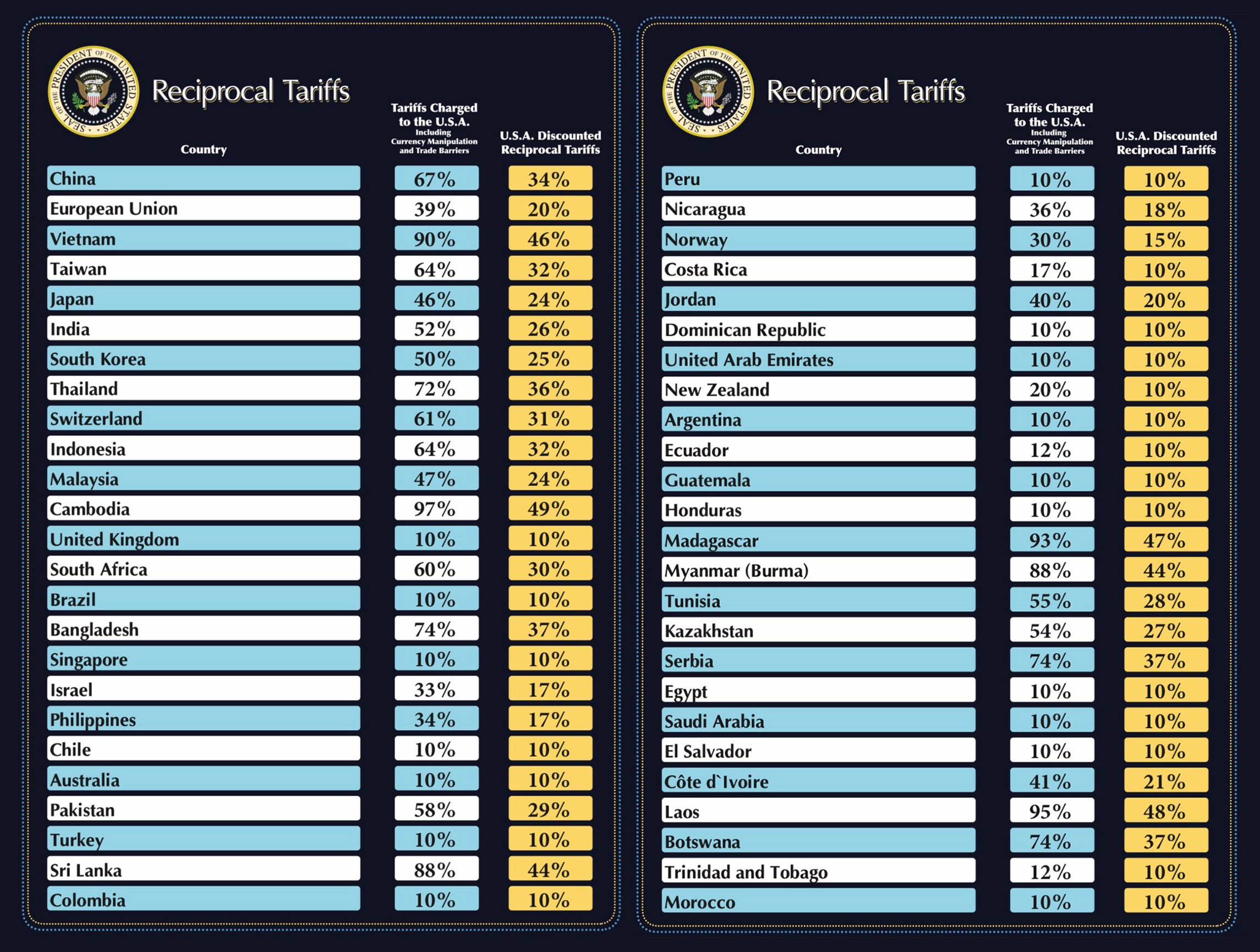Trump will impose tariffs of between 10% and 50% on countries around the world: “We Will Make America Rich Again”
- A global tariff of 10% for the whole world will be imposed by the Donald Trump administration, which will further tax imports from several countries, including China (34%) and the EU (20%). But the countries of the Global South will be the most affected: Lesotho (50 per cent), Madagascar (47 per cent) or Myanmar (44 per cent) affected by the recent earthquake.

With big bombs and an almost messianic tone, U.S. President Donald Trump has announced in the usual way, at the White House event he has called “Freedom Day,” that the era of “robbery of the U.S. in the last 50 years is over.” It has announced a “universal” tariff for the whole world: from now on anyone who wants to import their goods or products into the United States will be subject to a 10% tax without exception, no matter if they are from a small island in Oceania.
But Trump’s crackdown has gone further and will impose a higher tariff on countries and territories that have “misbehaved” commercially with the United States. China is one of them, as it will impose a tariff of 34%, which, with the addition of those already established, would reach 54%. The countries of the European Union have again been sanctioned with a 20% tariff.
But with the new tariffs, the most affected countries will be those in the less-favoured areas of the world called the Global South. For example, it will impose 47% on Madagascar, 50% on Lesotho, 48% on Laos, 46% on Vietnam, 37% on Botswana, or 44% on Myanmar, which has recently suffered a major earthquake. It is precisely the countries where Chinese investors have a strong presence, and many have seen a way to castigate the production of the Asian giant behind it.
The countries of the Global South where Chinese investors have a strong presence are precisely those that will bear the highest tariffs, and many have seen a way to castigate the production of the Asian giant behind it
A manipulated table in the hand
Trump has shown a large poster at the event that shows from country to country what tariffs they think they impose on U.S. products, and they are next to what the U.S. will now impose, with supposed “reciprocity.” In the percentages it is clear that the ones that the US will implement are much lower, however. “I think they’ll understand,” said the White House tenant. But experts say that the data in the table is completely manipulated because it has confused the trade deficit with tariffs.

The trade deficit is only a consequence of the economic system created by the United States itself. The United States has been an open market and has imported goods from all over the world for its own domestic consumption and production. Now he wants to change his decades-long strategy and embark on an era of protectionism to reindustrialize the country. But this can lead to an increase in inflation in the U.S., an increase in the price of products for the population, and the country’s entry into recession.
“Disastrous consequences for millions of people around the world”
Authorities around the world have reacted immediately after Trump’s announcement of global tariffs, and the impact on value markets has also been significant. Ursula Von der Leyen, President of the European Commission, said the consequences would be “deplorable” for “millions of people around the world.” The European Commissioner explains that they are willing to negotiate with the US, but that if these negotiations fail, the EU has the tools to respond to these tariffs.
China, for its part, has asked the United States to cancel its tariffs, and if it does not, it will respond with the same currency.

We'll find out.
At the moment, Asian exchanges, such as the Nikkei Index, have started their day with losses of around 3%, and European ones have also taken a downward trend, they are losing 2% when completing this news. The multinationals mainly linked to the automotive sector are the ones that are suffering the greatest losses. In fact, Trump announced on Wednesday that he will impose a specific 25% on the automotive industry within the global tariffs.
Trump announced on Wednesday that as part of the tariffs, he also imposes a specific global tax limit of 25% on the automotive industry
A 10% global tariff would go into effect on April 5 and higher “reciprocity” tariffs on April 9.
It remains to be seen how the global macro-economy will be affected by the direction Washington has taken. Instead of enforcing the tariffs previously imposed on Canada and Mexico, Trump has been delaying them to use them as bargaining tools for other purposes. Perhaps they will be with this hope in the dispatches of many companies. The rest of us will find out when we go shopping.
Bandera amerikanoz inguratuta, muga-zergen oldarraldi berria iragarri zion munduari Donald Trumpek apirilaren 2an. Geroztik hamaika astindu jasan dituzte burtsek eta nazioarteko merkataritzak. Baina hau ez da zoro baten boxeorako ringa bakarrik: AEBetako politikan hamarkada... [+]
Washington, D.C., June 17, 1930. The U.S. Congress passed the Tariff Act. It is also known as the Smoot-Hawley Act because it was promoted by Senator Reed Smoot and Representative Willis Hawley.
The law raised import tax limits for about 900 products by 40% to 60% in order to... [+]
At the beginning of the year, the Zedarria group publicly supported the "opening of the debate" on the "defense" industry (as well as the nuclear industry), to which the Basque Government has immediately joined. First, through Mikel Torres, Vice President and Economic Counselor, who... [+]
Public education teachers have the need and the right to update and improve the work agreement that has not been renewed in fifteen years. For this, we should be immersed in a real negotiation, but the reality is deplorable. In a negotiation, the agreement of all parties must be... [+]




















